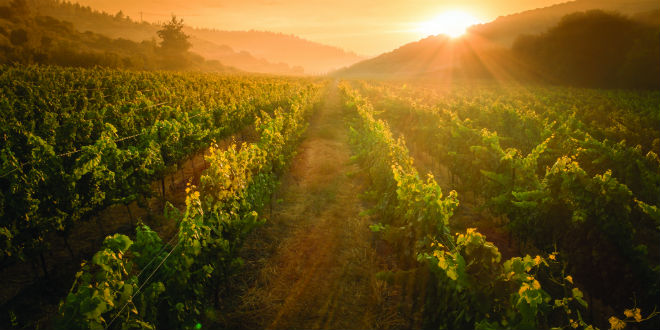Grapes have been cultivated for making wine since the time of Noah or even before. Although alcohol got the man of the Ark into trouble, wine indeed gladdens the heart of humankind and is a way for people to celebrate as long as they don’t overdo it and get intoxicated.
Growing grapes to make wine is a big industry in California, Israel and numerous other Mediterranean countries due to their climate. Most cultivated vineyards worldwide are located in semi‐arid and arid regions where drought is common and vines have to be irrigated.
There has been very limited information in the scientific literature about the effects of stress on the development of the adult grapevine system or on the implications of the plant’s ability to cope with drought.
Now, a new study published by scientists at Ariel University of Samaria and the Hebrew University of Jerusalem – published in the American Journal of Botany – has suggested a way to create higher-quality grapes and red wines. The growing season in Israel is from early spring to late summer.
Their article is titled “Water availability dynamics have long‐term effects on mature stem structure in Vitis vinifera.” This variety of Merlot grapes grow on a climbing vine that is of global economic importance.
The research was conducted by doctoral student Sarel Munitz, under the joint supervision of Dr. Yishai Netzer and Dr. Ilana Shtein of Ariel University and Hebrew University Prof. Amnon Schwartz. The team spent four years studying perennial vines and grapes grown in Kibbutz Hulda in central Israel. The vineyard was planted there in 1998.
It is relatively easy to get a large grape harvest that is considered poor for wine production – simply watering the vines a lot. But overwatering creates damage to the vine and the grape pulp.
When the vines get abundant water, the grapes are large and fat, but the wine will turn out to be relatively tasteless and flat, and the colors of the grape juice is pinking. Vines that undergo “thirst” – or “stress” – produce grapes with a better aroma and taste and make the wine better, the researchers wrote.
Their technique involves changing the natural anatomy of the vines so they suit the exact needs for creating the desired wine. Irrigation of the vines is increased during the early part of growing season and reduced at the end. This means that the plants are made to be “thirsty” in a controlled way, at the proper time, without harming the harvest This increases the amount of grapes grown and improves the quality of the wine.
The big question is how much farmers should irrigate to create the right balance. The recommendation of the research team is to water the vines more at the beginning of the season and make them “thirstier” in the weeks before they are harvested.
It turns out that plants have “memory,” which means that plants recall what exists within their anatomy. The memory mechanism is deeply embedded in the diameter of the tubes, called xylem, that transport water from the soil to the leaves and the fruits. The vascular tissue that transports soluble organic compounds manufactured during photosynthesis– especially the sugar sucrose – to parts of the plant is called phloem. Both types of tubes are comprised of dead cells.
The plant actually spreads risks: On the one hand, it can produce wide tubes that allow transport of large amounts of water, but there is a risk of air bubbles entering and blocking them. If the tubes created by the plant are narrow, less water reaches the leaves and fruit, but air bubbles are much less likely to form – even under severe dry conditions. Both narrow and fat tubes are found in the same vine.
The technologies they developed makes it possible to control the amount of stress in the vine and measure and control on a daily basis the exact amount of water used for irrigation and how much each vine needs to “drink.” The plant actually tells the farmer what its needs are to create high-quality wine and to prevent significant damage to the vine.
When the vines are watered generously, large, fat grapes are produced and the wine has a pinkish color. A plant that undergoes stress produces color, taste and aroma that give the wine uniqueness and quality. The balance between abundant water and thirst creates the ideal grapes for making wine.
“Our research can contribute to the understanding of mature stem xylem structure and how it is affected by drought stress in the long term” the Israeli researchers concluded. “This long‐term memory of xylem structure can be relevant for other woody plants, particularly in those in which xylem annual rings are hydraulically active for several years. High water availability during xylem formation period, results in wider vessels and increased hydraulic conductivity. This improved hydraulic system, even though favorable during periods of high water availability, is more prone to cavitation during drought periods.”
Source: Israel in the News

